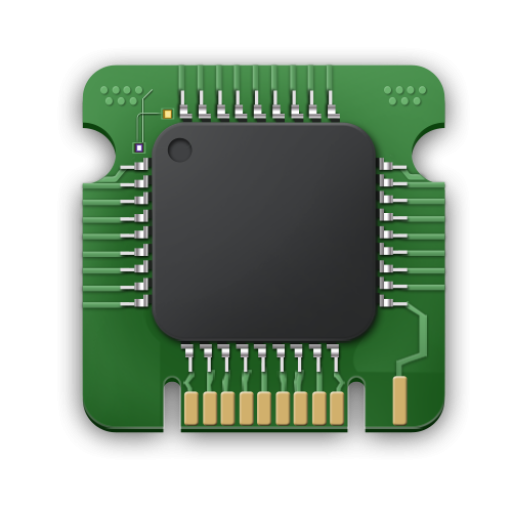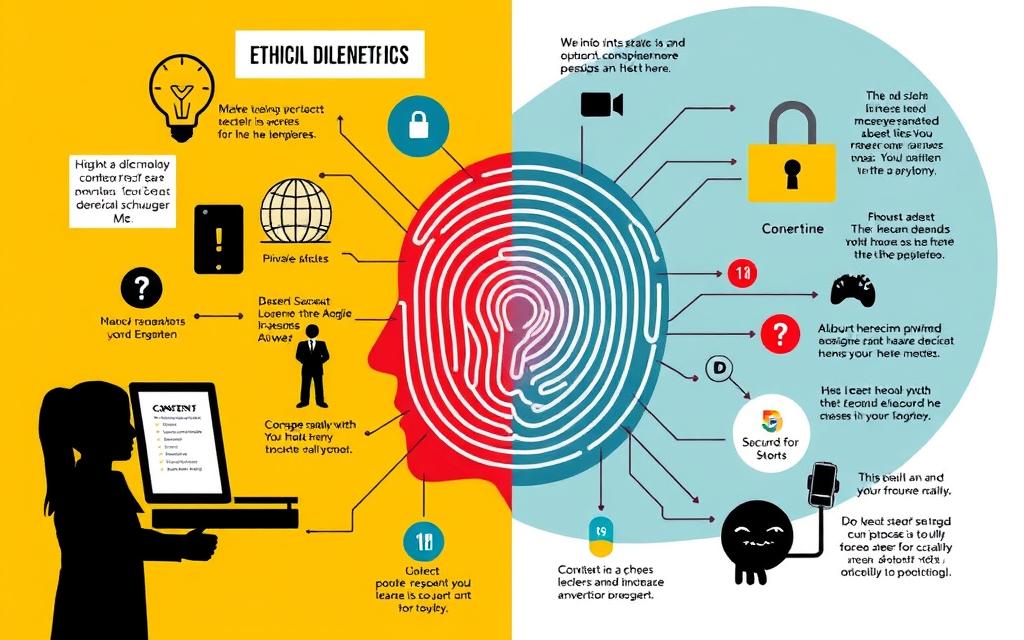Exploring the Ethical Issues of Biometric Technology
The rapid integration of biometric technology into daily life has sparked a complex debate about its ethical implications. Biometric systems, which collect and process unique physical and behavioral characteristics, are increasingly used in both public and private sectors, raising significant privacy concerns.
One of the primary ethical issues surrounding biometric technology is the tension between its security benefits and potential privacy violations. While biometric systems offer enhanced security measures, they also collect highly sensitive personal data that requires special ethical consideration.
Biometric data differs fundamentally from other forms of personal information. Its unique nature necessitates a careful examination of how it’s collected, stored, and used. The guide will explore how biometric technology’s rapid advancement is outpacing regulatory frameworks and ethical guidelines, creating a challenging landscape for both users and implementers.
This comprehensive guide aims to provide a balanced view of both the advantages of biometric systems and the ethical issues they raise in contemporary society. By examining the complex ethical landscape surrounding biometric technology, we can better understand the need for robust ethical frameworks and regulations to govern its use.
The increasing integration of biometric technology into our daily lives demands a thorough investigation into its ethical implications. As we move forward, it’s crucial to address the fundamental tension between security benefits and potential privacy violations that biometric technologies present.
Understanding Biometric Technology
The growing use of biometric technology is reshaping various aspects of our daily lives. As we increasingly rely on this technology for security, convenience, and efficiency, it’s essential to understand its fundamental principles and evolution.
Definition and Core Concepts
Biometric technology refers to the use of unique physical or behavioral characteristics to identify or authenticate individuals. This technology relies on advanced sensors and algorithms to capture and process biometric data, such as fingerprints, facial features, or voice patterns. At its core, biometric technology aims to provide secure and convenient identity verification, reducing the need for traditional methods like passwords or ID cards.
Biometric systems typically involve three key processes: enrollment, where biometric data is initially captured and stored; verification, where a user’s biometric data is compared to their stored data; and identification, where a user’s biometric data is compared against a database of stored records. These processes rely on sophisticated algorithms and machine learning techniques to ensure accuracy and security.

Evolution of Biometric Systems
Biometric systems have undergone significant transformations over time. From simple fingerprinting techniques to advanced multi-modal biometric technologies, the field has seen tremendous advancements. Initially, biometric technology was primarily used in government and high-security applications. However, with improvements in accuracy, affordability, and accessibility, it has expanded into commercial and consumer markets.
The evolution of biometric technology has been driven by both security needs and convenience factors. Key technological breakthroughs, such as the miniaturization of sensors and advances in computing power, have enabled biometric technology to become integrated into everyday devices. Furthermore, the incorporation of artificial intelligence and machine learning has dramatically improved the capabilities of modern biometric systems, making them more reliable and efficient.
Types of Biometric Technologies
Biometric technologies have evolved to include a range of methods, primarily categorized into physiological and behavioral biometrics. This section will explore the different types of biometric technologies, their applications, and the unique characteristics of each.
Physiological Biometrics
Physiological biometrics involves the measurement of physical characteristics to identify individuals. These methods are often more straightforward and have been in use for longer than behavioral biometrics.
Fingerprints and Hand Geometry
Fingerprint recognition is one of the most widely used biometric technologies, leveraging unique patterns found on an individual’s fingertips. Hand geometry, on the other hand, measures the shape and size of a person’s hand. Both methods are used for secure identification in various applications, including access control and identity verification.
Facial Recognition
Facial recognition technology analyzes facial features to verify an individual’s identity. This method has gained popularity in security and surveillance systems due to its non-intrusive nature. As noted by a security expert, “Facial recognition is becoming increasingly prevalent in our daily lives, from unlocking smartphones to enhancing airport security.”
“The use of facial recognition technology raises important questions about privacy and surveillance.”
Iris and Retinal Scanning
Iris scanning captures the unique patterns in the iris of an individual’s eye, while retinal scanning examines the blood vessels at the back of the eye. Both are highly secure methods of biometric identification, used in high-security environments.
Behavioral Biometrics
Behavioral biometrics focuses on the measurement of patterns in human behavior to identify individuals. These methods can offer continuous authentication, enhancing security beyond traditional point-in-time verification.
Voice Recognition
Voice recognition technology has been used to verify individuals’ identities, particularly over the phone when accessing government services. It analyzes the unique characteristics of a person’s voice, providing a convenient method of authentication.
Gait Analysis
Gait analysis involves the study of an individual’s walking pattern to identify them. This method is less common but has potential applications in surveillance and security.
Keystroke Dynamics
Keystroke dynamics analyzes the typing patterns of individuals, including rhythm, speed, and pressure, to identify them. This behavioral biometric provides continuous authentication, making it valuable for cybersecurity and fraud prevention. The applications of keystroke dynamics include:
- Continuous authentication for enhanced security
- Improved fraud prevention in financial transactions
- Secure access to sensitive information
How Biometric Systems Work
Biometric systems operate through a complex process involving data capture, processing, and comparison. These systems are designed to securely identify or authenticate individuals using unique biological or behavioral characteristics.
Enrollment Process
The enrollment process is the initial step where an individual’s biometric information is captured and stored in a database. This involves scanning or recording the person’s biometric characteristic, such as a fingerprint or facial features, and converting it into a digital template.
The captured data is then processed to extract distinctive features, which are stored as a template in the database. This template is used for future comparisons to authenticate or identify the individual.
Authentication Methods
Authentication methods in biometric systems involve verifying a person’s claimed identity by comparing their presented biometric data against the stored template. This is typically a one-to-one comparison, where the system checks if the presented biometric data matches the template associated with the claimed identity.
The process ensures that the person is who they claim to be, providing a secure method of authentication.
Identification Processes
Identification processes, on the other hand, involve a one-to-many comparison where the presented biometric data is compared against multiple templates stored in the database to determine the individual’s identity. This process answers the question “Who are you?” without requiring a prior identity claim.
Biometric identification systems face computational challenges, especially with large databases. To improve efficiency, techniques such as indexing and filtering are employed to narrow down the search.
“The use of biometric identification raises significant privacy concerns, as it enables the recognition of individuals without their knowledge or consent.”

The identification process is complex and requires balancing the need for security with the need to protect individual privacy. As biometric technologies continue to evolve, addressing these challenges will be crucial.
Applications of Biometric Technology
The applications of biometric technology are diverse, ranging from government and public sector use to commercial and personal device security. Biometric technology has become a cornerstone in enhancing security and identity verification across various sectors.
Government and Public Sector Use
Biometric technology is increasingly being adopted by governments and public sector agencies for various purposes, including border control, identity verification, and law enforcement. For instance, biometric passports and identity cards are being used to prevent identity fraud and enhance national security. The use of biometrics in government services also helps in streamlining processes such as voter registration and welfare distribution.
Commercial Applications
In the commercial sector, biometric technology is being utilized for secure authentication and identity verification. Businesses are using biometrics to enhance customer experience and security in various applications, including financial transactions and access control. For example, biometric authentication is being used in banking to secure transactions and prevent fraud.
Personal Device Security
Biometric technology has become a standard security feature in smartphones, tablets, and laptops, revolutionizing the way we secure our personal devices. The evolution from PIN codes and passwords to fingerprint sensors, facial recognition, and voice authentication has not only enhanced security but also provided convenience to device users. Local storage of biometric templates on devices addresses some privacy concerns, although limitations and potential vulnerabilities exist. The widespread adoption of biometrics in personal devices has contributed to the normalization of this technology.
As biometric technology continues to advance, its applications are expected to expand further, transforming various aspects of our lives. The unique characteristics of biometrics make them an effective and reliable method for identity verification, offering enhanced security and convenience.
What Are the Ethical Issues of Biometric Technology
The increasing use of biometric technology has raised significant ethical concerns that need to be addressed. As we rely more heavily on these systems for security, identification, and authentication, it’s crucial to consider the implications of their use.
Privacy Concerns
One of the primary ethical issues surrounding biometric technology is the potential invasion of privacy. Biometric data, such as fingerprints, facial recognition information, and DNA samples, is highly personal and sensitive. The collection and storage of this data raise concerns about how it is used, shared, and protected. For instance, the use of facial recognition technology in public spaces has sparked debates about surveillance and the right to privacy.
To understand the scope of privacy concerns, let’s examine the following data:
| Biometric Data Type | Privacy Risk Level | Common Use Cases |
|---|---|---|
| Fingerprints | High | Device unlocking, border control |
| Facial Recognition | High | Surveillance, identity verification |
| DNA Samples | Very High | Forensic analysis, health diagnostics |
Consent and Autonomy
Another critical ethical issue is the matter of consent and autonomy. Individuals must be fully informed and provide consent before their biometric data is collected and used. However, in many cases, people may not be aware that their biometric data is being collected, or they may not have a choice in the matter. For example, the use of biometric technology in the workplace or in public spaces may be mandatory, raising questions about autonomy and coercion.

Discrimination and Bias
Biometric systems can also perpetuate bias and discrimination if they are not designed and trained carefully. Facial recognition algorithms, for instance, have been shown to have higher error rates for women and people with darker skin tones. This can lead to unfair outcomes in areas such as law enforcement, employment, and access to services. It’s essential to address these biases to ensure that biometric technology is used fairly and equitably.
To mitigate these issues, developers and implementers must take steps to test for and mitigate bias in biometric systems. This includes using diverse training datasets and regularly auditing systems for discriminatory outcomes.
Privacy Challenges in Biometric Data Collection
The collection of biometric data raises significant privacy concerns that need to be addressed. Biometric data, by its nature, is highly personal and sensitive, making the manner of its collection crucial to maintaining individual privacy.
Covert Collection Concerns
One of the primary privacy challenges is the potential for covert collection of biometric data. This occurs when individuals are not aware that their biometric information is being collected or processed. For instance, surveillance cameras with facial recognition capabilities can capture and analyze individuals’ facial biometrics without their knowledge or consent.
This raises significant concerns about privacy and the potential for misuse of such data. The lack of transparency in data collection processes can erode trust in institutions and technologies that employ biometric data collection.

Secondary Information Extraction
Biometric data can often reveal more than just an individual’s identity. For example, facial recognition data can potentially disclose health conditions or emotional states. A raw image of a facial biometric could reveal health information that an individual may not wish to share.
The extraction of secondary information from biometric data poses ethical challenges. It is essential to consider the concept of “data dignity” and individuals’ right to control information derived from their biological characteristics.
| Type of Biometric Data | Potential Secondary Information |
|---|---|
| Facial Biometrics | Health conditions (e.g., Down syndrome), emotional states |
| Voice Patterns | Emotional states, health conditions, pregnancy |
| DNA Biometrics | Family relationships, disease predispositions, genetic information |
As highlighted by a recent study, “The use of biometric data for purposes beyond identification raises significant ethical concerns, particularly regarding privacy and consent.” Ensuring that individuals are aware of and consent to the collection and use of their biometric data is crucial.
The potential for discrimination based on secondary information extracted from biometric data is also a significant concern. This underscores the need for robust regulations and ethical frameworks to govern the use of biometric technologies.
Security Vulnerabilities and Risks
Biometric systems, despite their advantages, are not immune to security risks. As with other security measures, the use of biometrics has vulnerabilities that can be compromised. For instance, fake artifacts, such as replicas of biometric characteristics, can be created to fool biometric sensors, a technique commonly known as spoofing.
Data Breaches and Identity Theft
One of the significant risks associated with biometric systems is the potential for data breaches and identity theft. When biometric data is stored, it becomes a target for hackers. If this data is compromised, it can lead to severe consequences, as biometric characteristics are immutable and cannot be changed like passwords.
For example, in 2019, a significant data breach exposed millions of fingerprint records, highlighting the vulnerability of biometric data storage. Such breaches underscore the need for robust security measures to protect biometric data.
Spoofing and System Manipulation
Spoofing is a significant threat to biometric systems, where attackers use fake biometric samples to deceive the system. Techniques include using artificial fingerprints, 3D-printed face masks, and voice recordings to bypass security checks.
| Spoofing Technique | Description | Countermeasure |
|---|---|---|
| Artificial Fingerprints | Using fake fingerprints to mimic real ones | Liveness detection |
| 3D-Printed Face Masks | Creating masks to resemble individuals | Advanced facial recognition algorithms |
| Voice Recordings | Recording and replaying voices | Voice liveness detection |
To mitigate these risks, it’s essential to implement advanced security measures, such as liveness detection, which can determine whether a biometric sample is from a living person or a fake representation. The ongoing challenge is to stay ahead of spoofing techniques and ensure the integrity of biometric systems.

Function Creep and Unauthorized Use
The use of biometric technology has raised concerns about function creep, where data collected for one purpose is used for another, often without proper authorization. This phenomenon poses significant risks to individual privacy and autonomy.
Mission Expansion Beyond Original Purpose
Biometric data collected for a specific purpose can be repurposed for other uses, often without the knowledge or consent of the individuals involved. For instance, facial recognition technology initially implemented for security purposes can be used for targeted advertising and consumer profiling. According to the Office of the Victorian Information Commissioner, such practices raise significant privacy concerns and highlight the need for robust regulatory frameworks to prevent the unauthorized use of biometric data.
Commercial Exploitation of Biometric Data
The commercial exploitation of biometric data is a growing concern. Biometric information can be sold or shared with third parties, often without proper oversight or regulation. This can lead to the manipulation of consumer behavior through emotional recognition derived from facial expressions or voice patterns. The commodification of biometric data raises ethical questions about the balance between commercial interests and individual privacy rights.
Some of the key issues related to the commercial exploitation of biometric data include:
- The use of facial recognition in public spaces for targeted advertising
- The sale or sharing of biometric data with third parties
- The manipulation of consumer behavior through emotional recognition
- The tension between commercial interests and privacy rights
To address these concerns, regulatory approaches are being explored to prevent the unauthorized commercial exploitation of biometric data. It is essential to strike a balance between the benefits of biometric technology and the need to protect individual privacy and autonomy.

Biometric Technology in Surveillance
The increasing use of biometric technology in surveillance has raised significant concerns regarding public space monitoring and individual privacy. Biometric surveillance, particularly facial recognition technology, is being deployed in various public spaces, including streets, parks, and transportation hubs.
Public Space Monitoring
Facial recognition technology is being used to monitor public spaces, often under the guise of enhancing security. However, this has sparked concerns about the potential for mass surveillance and the erosion of individual privacy. In cities where facial recognition is used, citizens are often unaware that their faces are being scanned and recorded.
The use of facial recognition technology in public spaces can have a chilling effect on individuals, making them less likely to participate in public gatherings or exercise their right to free speech. This is particularly concerning in countries where protests and demonstrations are common, as it can be used to identify and track participants.
Impact on Civil Liberties
The deployment of biometric surveillance technologies has significant implications for civil liberties, including the right to privacy and freedom of assembly. The use of facial recognition technology can create a chilling effect, where individuals self-censor or avoid certain activities due to the awareness of being surveilled.
Moreover, biometric surveillance can disproportionately impact marginalized communities and political dissidents. In countries with a history of human rights abuses, biometric surveillance has been used to target activists, journalists, and minority groups. It is essential to ensure that biometric surveillance systems are subject to democratic oversight and accountability to protect the rights of individuals.
In conclusion, the use of biometric technology in surveillance raises significant concerns regarding public space monitoring and individual privacy. It is crucial to strike a balance between security needs and the protection of civil liberties, ensuring that biometric surveillance systems are transparent, accountable, and subject to robust oversight.
Limitations of Biometric Systems
While biometric systems offer a high level of security, they are not immune to certain limitations that can compromise their functionality. One of the primary concerns is the permanent nature of biometric characteristics.
Failure to Enroll Issues
One limitation is the failure to enroll (FTE) rate, where certain individuals are unable to register their biometric data due to various reasons such as poor quality fingerprints or eye conditions. This can lead to exclusion of legitimate users, highlighting the need for alternative authentication methods.
False Acceptance and Rejection Rates
Biometric systems are also plagued by false acceptance rates (FAR) and false rejection rates (FRR). FAR occurs when an unauthorized user is incorrectly authenticated, while FRR happens when a legitimate user is denied access. Balancing these rates is crucial for the system’s overall security and usability.
Compromised Biometrics
Unlike passwords or ID tokens, biometric characteristics cannot be reissued or cancelled if compromised. This represents a significant security risk, as stolen biometric templates can be used for fraudulent purposes. The concept of “cancellable biometrics” has emerged as a potential solution, where biometric data is transformed in a way that makes it difficult to reverse-engineer.
To mitigate the risks associated with compromised biometric data, multi-factor authentication can be employed. This involves combining biometric authentication with other forms of verification, such as passwords or smart cards, to enhance security.
| Limitation | Description | Potential Solution |
|---|---|---|
| Failure to Enroll | Inability to register biometric data | Alternative authentication methods |
| False Acceptance/Rejection | Incorrect authentication decisions | Balancing FAR and FRR |
| Compromised Biometrics | Irreversible biometric data theft | Cancellable biometrics, multi-factor authentication |
The limitations of biometric systems underscore the need for ongoing research and development to address these challenges. By understanding and mitigating these limitations, we can enhance the security and reliability of biometric information.
Legal Frameworks and Regulations
The legal frameworks governing biometric technology are as diverse as the technologies themselves, reflecting a complex global regulatory landscape. This diversity is a result of different countries and regions adopting unique approaches to regulating biometric data, driven by varying concerns over privacy, security, and the potential for misuse.
UK and EU Regulations
In the UK and EU, biometric data is subject to stringent regulations. The EU’s General Data Protection Regulation (GDPR) provides a comprehensive framework for the protection of personal data, including biometric data. The GDPR categorizes biometric data as a special category of personal data, requiring enhanced protection. The UK, post-Brexit, has maintained similar regulations through the UK GDPR and the Data Protection Act 2018. For more information on privacy policies, you can visit techhack.co.uk/privacy-policy/.
| Regulation | Description | Jurisdiction |
|---|---|---|
| GDPR | Comprehensive data protection regulation | EU |
| UK GDPR | UK’s version of GDPR post-Brexit | UK |
| Data Protection Act 2018 | UK legislation complementing UK GDPR | UK |
Global Regulatory Approaches
Globally, the regulation of biometric data varies significantly. In the United States, there is a patchwork of state laws rather than a comprehensive federal legislation on biometric privacy, with Illinois’ Biometric Information Privacy Act being a notable example. Countries with large-scale biometric programs, like India’s Aadhaar system, have their own regulatory frameworks. The challenge lies in regulating rapidly evolving biometric technologies through traditional legislative processes. International organizations and standards bodies play a crucial role in developing global norms for biometric technology, balancing national security interests with privacy protections.
The diverse regulatory approaches highlight the need for a nuanced understanding of biometric data protection. As biometric technology continues to advance, it is crucial for governments to adapt their regulatory frameworks to address emerging challenges and ensure the protection of individuals’ rights.
Biometric Data as Sensitive Information
Biometric data is increasingly recognized as a sensitive category of personal information that requires special protection. As such, it is crucial to understand the implications of handling and storing this data.
Special Categories of Personal Data
Biometric data falls under special categories of personal data due to its unique and permanent nature. This classification necessitates heightened security measures to prevent unauthorized access and misuse. Organizations handling biometric data must implement robust safeguards, including encryption and secure storage architectures, to protect this sensitive information.
The storage of raw biometric images requires particularly stringent security controls, along with regular monitoring and auditing to prevent data breaches. According to a report, organizations should consider the risks of becoming a target for criminals seeking biometric data for identity theft (further reading on biometric data security).
Enhanced Protection Requirements
To adequately protect biometric data, organizations must adopt a multi-faceted approach. This includes implementing technical safeguards like template protection and procedural protections such as access controls and audit trails. The principle of “privacy by design” should be integral to the development of biometric systems, ensuring that data minimization principles are adhered to.
Furthermore, organizations should establish strict data retention limitations and secure deletion protocols for biometric information. Enhanced notification requirements should be in place in the event of a biometric data breach, ensuring transparency and accountability.
Ethical Principles for Biometric Implementation
Ethical principles play a crucial role in the responsible implementation of biometric technology, balancing security needs with individual rights. The deployment of biometric systems must be guided by a set of core principles that ensure their use is both effective and ethical.
Transparency and Accountability
Transparency is fundamental in the deployment of biometric systems. Organizations must be clear about how biometric data is collected, stored, and used. This includes providing individuals with information about the purpose of biometric data collection and ensuring that they are aware of their rights regarding this data. Accountability is also crucial, as organizations must be held responsible for any misuse or mishandling of biometric information. Implementing robust governance measures and regular audits can help ensure accountability.
For instance, a transparent biometric system would clearly inform individuals about data usage and provide them with options to control their data. This can be achieved through user-friendly interfaces that allow individuals to manage their biometric data effectively.
Proportionality and Necessity
The principles of proportionality and necessity are critical in evaluating the ethical deployment of biometric technologies. Organizations must assess whether the collection of biometric data is truly necessary for their stated purpose and ensure that the privacy impact is proportionate to the benefits. This involves considering less invasive alternatives and applying data minimization principles to collect only the biometric information needed for a specific function.
| Principle | Description | Application |
|---|---|---|
| Proportionality | Ensuring the privacy impact is proportionate to the benefits | Conducting impact assessments to weigh benefits against privacy risks |
| Necessity | Evaluating if biometric data collection is necessary for the stated purpose | Considering alternative methods before implementing biometric solutions |
| Data Minimization | Collecting only the necessary biometric information | Limiting data collection to what is required for the specific function |
Court cases, such as the one involving Mr. Bridges, where the use of AFR Locate was evaluated, demonstrate how these principles are applied in practice. The court accepted that while the use of AFR Locate interfered with Mr. Bridges’ privacy rights, this was outweighed by the powers of the police to prevent and detect crime, illustrating the balancing act required by the principles of proportionality and necessity.
Balancing Security and Privacy
As biometric systems become more prevalent, finding an equilibrium between security measures and privacy rights is crucial. The challenge lies in harnessing the benefits of biometrics for security purposes while protecting individual privacy.
The Security-Privacy Trade-off
The use of biometric technology for security purposes often involves a trade-off between enhancing security and potentially compromising privacy. On one hand, biometrics can significantly improve security by providing a more reliable means of identification. On the other hand, the collection and processing of biometric data raise significant privacy concerns.
To mitigate these concerns, privacy-enhancing technologies can be integrated into biometric systems. These technologies can help reduce the privacy impacts by minimizing the amount of personal data collected and processed.
Finding the Right Balance
Achieving the right balance between security and privacy requires a multifaceted approach. Governance frameworks that include diverse stakeholders can play a crucial role in decisions about biometric technology deployment. Independent oversight, sunset provisions, and regular reviews can help maintain an appropriate balance over time.
Furthermore, transparency and democratic accountability are essential in finding the right balance. The concept of “privacy by design” can ensure that privacy protections are built into biometric systems from the outset.
Different societies may find different balancing points between security and privacy in biometric applications. Ultimately, achieving a balance requires ongoing dialogue and adaptation to new challenges and technologies.
Future of Ethical Biometric Use
As biometric technologies continue to evolve, the need for ethical frameworks becomes increasingly important. The integration of biometrics into various aspects of life necessitates a careful examination of the ethical implications and the development of guidelines to ensure responsible use.
Emerging Technologies and Concerns
Advancements in areas such as liveness detection and cancellable biometrics are addressing some of the limitations of current biometric systems. However, these emerging technologies also raise new concerns. For instance, the increased sophistication of biometric systems can lead to heightened privacy risks if not properly managed.
The use of biometric data in new contexts, such as in mobile devices and online transactions, requires a reevaluation of existing ethical standards. Ensuring the security and integrity of biometric data is paramount, as is the need to prevent unauthorized access or misuse.
Developing Ethical Frameworks
Developing comprehensive ethical frameworks is crucial for guiding the responsible use of biometric technologies. This involves several key steps, including the establishment of ethics committees, conducting impact assessments, and engaging in stakeholder consultations.
Operationalizing ethical principles into practical guidelines for developers of biometric systems is essential. This includes incorporating diverse perspectives to ensure that the frameworks are robust and applicable across various contexts.
| Component | Description | Importance |
|---|---|---|
| Ethics Committees | Oversee the ethical implementation of biometric technologies | High |
| Impact Assessments | Evaluate the potential effects of biometric systems on individuals and society | High |
| Stakeholder Consultations | Engage with various stakeholders to ensure diverse perspectives are considered | Medium |
The development of frameworks must be an ongoing process, adapting to new technological developments and societal needs. International cooperation is also vital for establishing shared ethical standards across borders.
Moreover, professionals working in the field of biometric technology must adhere to professional ethics, ensuring that their work is conducted with integrity and respect for individual rights.
Conclusion
Biometric technology, while offering enhanced security and convenience, poses substantial ethical challenges that need to be addressed. Throughout this article, we have explored the various ethical issues surrounding biometric technology, including privacy concerns, the potential for discrimination, and the risks associated with the collection and storage of biometric data.
The tension between the benefits of biometric systems for security and their potential negative impacts on privacy and civil liberties is a recurring theme. On one hand, biometric technology offers a robust tool for enhancing security and streamlining various processes. On the other hand, it raises significant concerns regarding individual privacy and autonomy.
Thoughtful regulation and ethical implementation of biometric technologies are crucial to mitigating these risks. This includes ensuring transparency in how biometric data is collected, used, and stored, as well as implementing robust accountability measures to prevent misuse.
Moreover, ongoing dialogue between technologists, policymakers, ethicists, and the public is essential to navigate the evolving landscape of biometric technology. By fostering a collaborative approach, we can work towards solutions that balance the benefits of biometric technology with the need to protect fundamental rights and values.
Ultimately, biometric technology is not inherently problematic; its ethical implications depend on how it is designed, deployed, and governed. By prioritizing proportionality, transparency, and accountability, we can harness the potential of biometric technology while minimizing its risks and addressing the concerns it raises.
As biometric technology continues to evolve and become more integrated into daily life, it is imperative that we remain vigilant and proactive in addressing its ethical issues. By doing so, we can ensure that the benefits of this technology are realized while respecting the rights and values of individuals.







